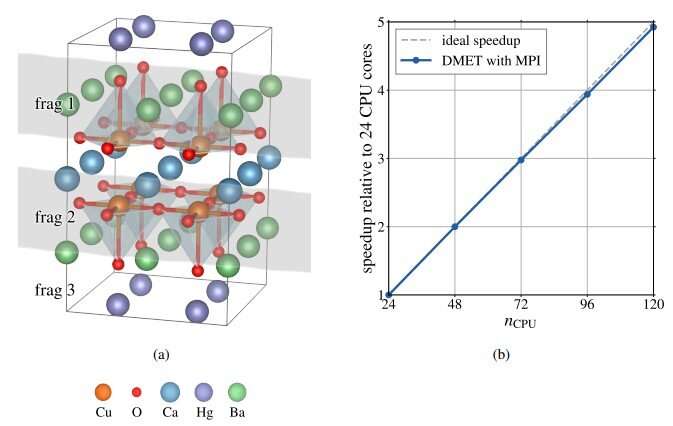(a) Illustration of the multi-fragmentation scheme in the multi-layer cuprate Hg-1212. The system is divided into 3 pieces: the fragments 1 and 2 involve the two Cu-O layers and fragment 3 contains all other ions in the cell. (b) MPI efficiency of the multi-fragment implementation of a h-BN crystal. Credit: Science (2022). DOI: 10.1126/science.abm2295
In just about any situation in which electricity is being used, whether it is lighting a bedroom at night, keeping frozen food cold, or powering a car that is taking a commuter to work, some of that electrical energy is lost as heat. This is called resistance. Materials with lower resistance are better at conducting electricity while materials with higher resistance are worse at it.
Though nearly all conductors exhibit some resistance, there are some materials that have no electrical resistance whatsoever. These are called superconductors, and their unique properties are used in technologies ranging from magnetic resonance imaging (MRI) to levitating trains.
However, most superconductors only superconduct when they are cold—really cold. Even so-called "high temperature" superconductors need to be cooled with liquid nitrogen to roughly -200 degrees Celsius to work.
That need for intense cooling adds a big complication to the use of superconductors. For decades, researchers have sought out superconductors that work at room temperature. Currently, at normal atmospheric pressure, the class of high temperature superconductors known as the cuprates—compounds containing both copper and oxygen atoms—come the closest, with the best-performing cuprate able to superconduct at temperatures as "warm" as -140 degrees Celsius.
Since -140 degrees Celsius is still quite cold, there is a long way to go before cuprates can be called room-temperature superconductors, and further advancement of these superconductors has been hampered by the fact that no one has figured out how cuprate superconductors work.
But now, researchers in the group of Garnet Chan, Caltech's Bren Professor of Chemistry, have developed a theory that explains some of the magnetic properties of cuprate superconductors. Cuprate superconducting materials exhibit a layer effect, where their magnetic and superconducting properties are enhanced as more layers of the constituent copper and oxygen atoms are brought together.
In a paper published in the journal Science, Chan and his coauthors explain how the magnetic layer effect arises from fluctuations of the electrons between the copper and oxygen atoms and their surrounding atoms.
"This is a first step toward understanding the governing principles behind the superconducting layer effect, and what controls the superconducting temperature in superconductors more generally," says Zhihao Cui, chemistry graduate student and first author of the study.
The paper is titled "Systematic electronic structure in the cuprate parent state from quantum many-body simulations" and appears in the September 8 issue of Science.
More information: Zhi-Hao Cui et al, Systematic electronic structure in the cuprate parent state from quantum many-body simulations, Science (2022). DOI: 10.1126/science.abm2295
Journal information: Science
Provided by California Institute of Technology
























